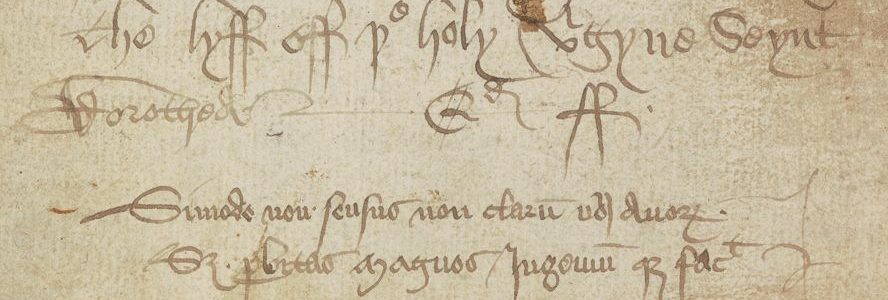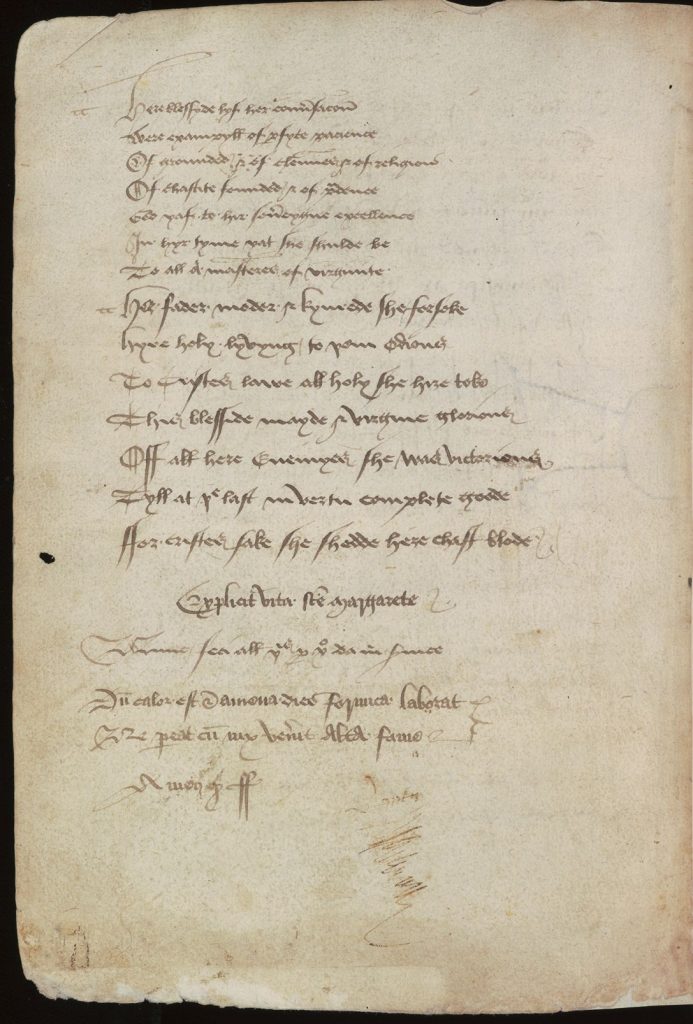
Devotion Made Digital: Encoding CUL MS Ll.5.18
Guest post by Katherine Dixon, a PhD student in the Faculty of English at Cambridge, on her experience of collaborating with the Cambridge Digital Library.
Just over a year ago I was introduced to the small fifteenth-century religious miscellany held in the University Library’s Special Collections, CUL MS Ll.5.18, following a very generous recommendation by Professor Richard Beadle. The charming manuscript, no more than 20 cm in height and 41 leaves in total, contains a selection of devotional vernacular texts: the final portion of the treatise The Direccion of a Mannys Lyfe, The Life and The Charter of the Abbey of the Holy Ghost, the Life of Saint Dorothy, a translated excerpt from Saint Augustine’s De contemptu mundi and John Lydgate’s Life of Saint Margaret.
This was the manuscript I chose to prepare for a compulsory coursework component of the Textual and Related Studies course for the English Faculty’s MPhil in Medieval and Renaissance Literature. Having been well-equipped by a term of intensive practical and theoretical training in medieval manuscripts, the project asked students to complete three main tasks:
- A full description of a manuscript of their own choice, including both codicological and paleographical analyses,
- An exercise offering a transcription, translation and edition of an excerpt from the manuscript,
- An essay investigating a noteworthy feature of the manuscript’s codicology or paleography in greater depth.
In and amidst the students’ work on their manuscripts, four additional classes and workshops were put on to support their studies. One of these was an introductory session on the Textual Encoding Initiative (TEI) offered by Huw Jones, head of the Digital Library Unit. The Initiative exists to develop and maintain an international standard for the representation of texts in digital form and has been designed to offer a universal method by which text artefacts may be rendered machine-readable. The potential applications of TEI in the humanities are vastly wide-ranging. Huw introduced the group to but one possible use of electronic text encoding: the Cambridge Digital Library (CUDL).
When I returned to the English Faculty to commence my PhD in Medieval Literature in the autumn, I also returned to my MPhil coursework and CUDL agreed to collaborate with me in preparing a digital edition of MS Ll.5.18. From the outset, it was clear that this truly was to be a joint effort and a mutually beneficial experience. While I was dependent upon the expert assistance of Huw and his team to encode my manuscript and its description, I was given the tools and support to do a great deal of the work myself and – all the more crucially – learn how to replicate each stage of the process independently in the future. Conversely, CUDL relies upon the indepth knowledge of those who have worked closely with the university’s special collections.
The library’s photographic resources are exceptional and the first stage of the project was to capture high-resolution images of MS Ll.5.18. These photographs not only capture the manuscript in time but also serve as a scholarly tool in the details they reveal. For instance, faint erasures can be distinguished more clearly than with the naked eye alone and the hand of a manuscript’s scribe enlarged to aid transcription. In addition, publishing a resource on CUDL makes an object, whose reach was once strictly limited, accessible to a global audience.
In light of these benefits, one might be tempted to see ‘photographing a manuscript’ and ‘digitising a manuscript’ as synonymous. Through my experience, however, I have learnt that this is far from the case and the value of CUDL far exceeds the distribution of high-quality photographs. The process of encoding a manuscript through TEI enmeshes image and description in a format that is designed to enable it to withstand technological change. As opposed to the data stored on multitudinous floppy disks that are virtually unreadable today, TEI stores information in a considerably more stable form.
All the more, TEI allows its writer(s) to signal different strata of knowledge. Should one wish to add to or re-evaluate the information that they originally encoded, each stage of the research process can be captured to give a full sense of the intellectual history of the text artefact in question. This quality of TEI was reiterated to me by CUDL, who explained that they were very happy for me to return to my manuscript description as my findings about its contents – whether major or minor – develop over time.
Having listed the many advantages of digitisation for others, I must conclude by saying that the most useful part of this experience was the process itself. I am now not only fully aware of the purposes behind and benefits of CUDL, but I also have a strong foundation in TEI, am appreciative of its many potential uses and equipped with the resources I need to envisage a project of my own.
You can view the completed project on the Cambridge Digital Library.

